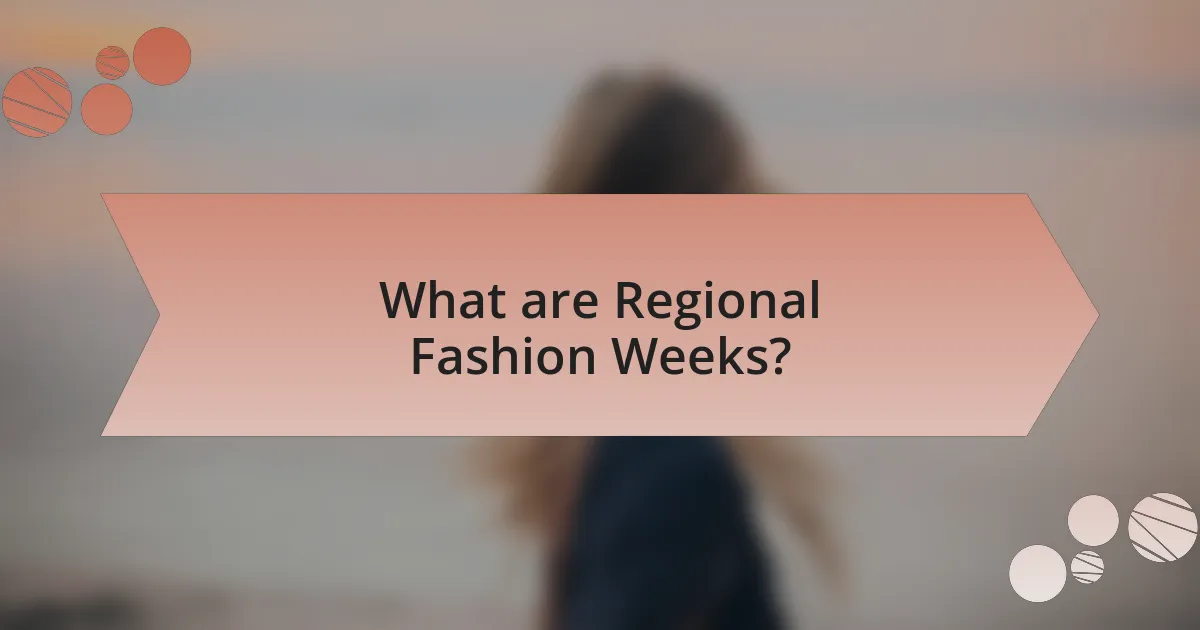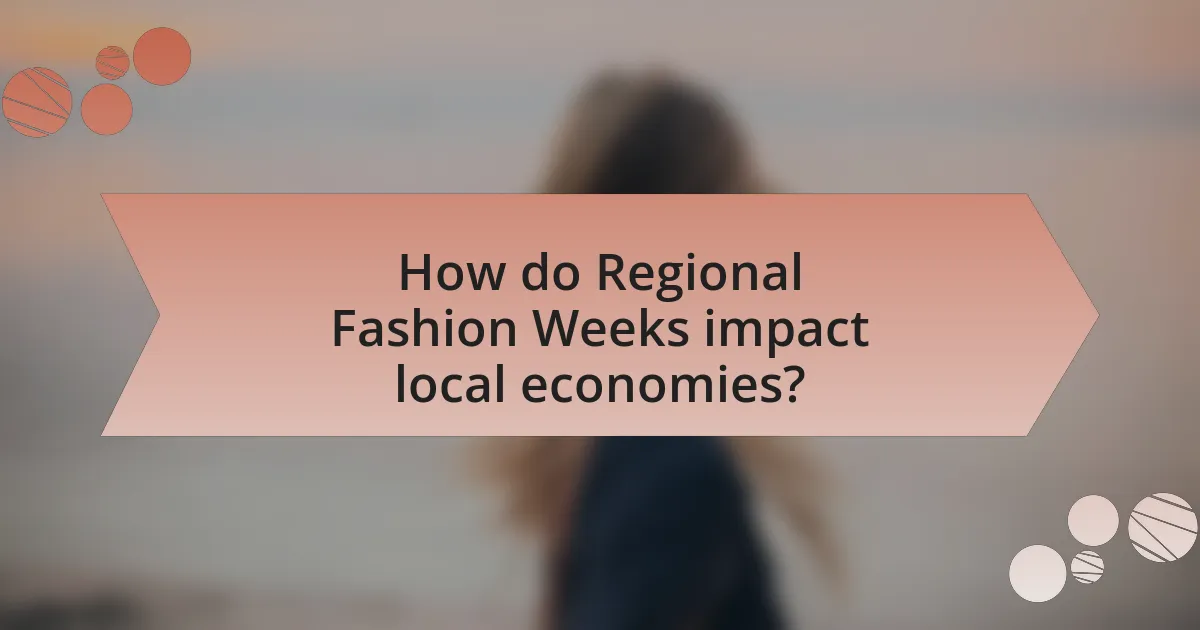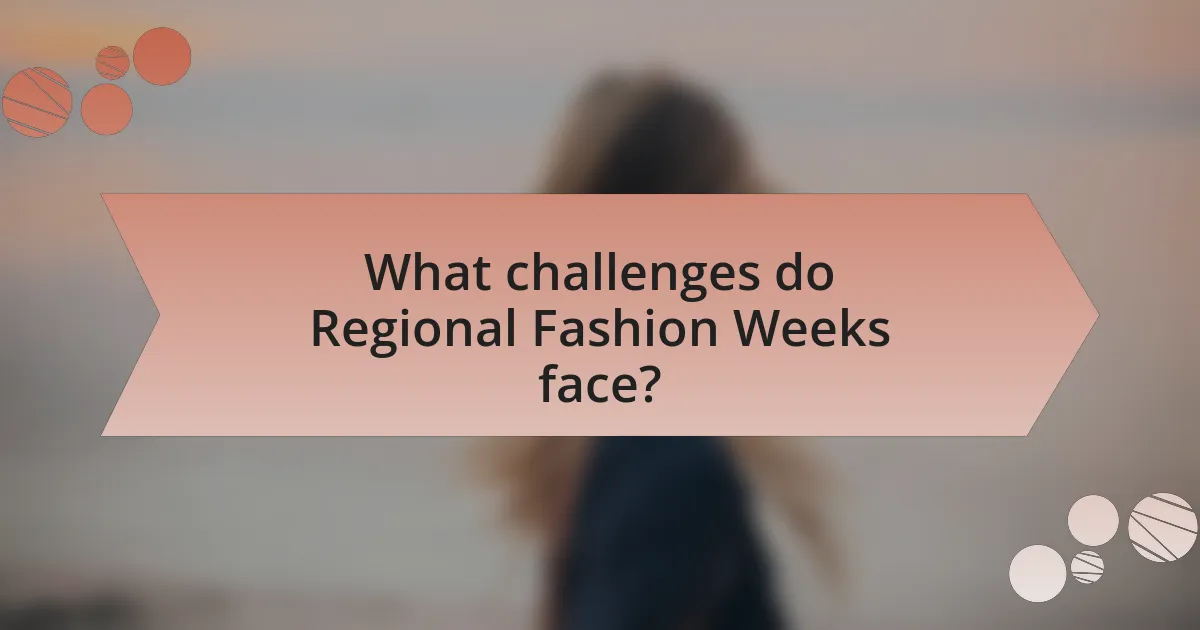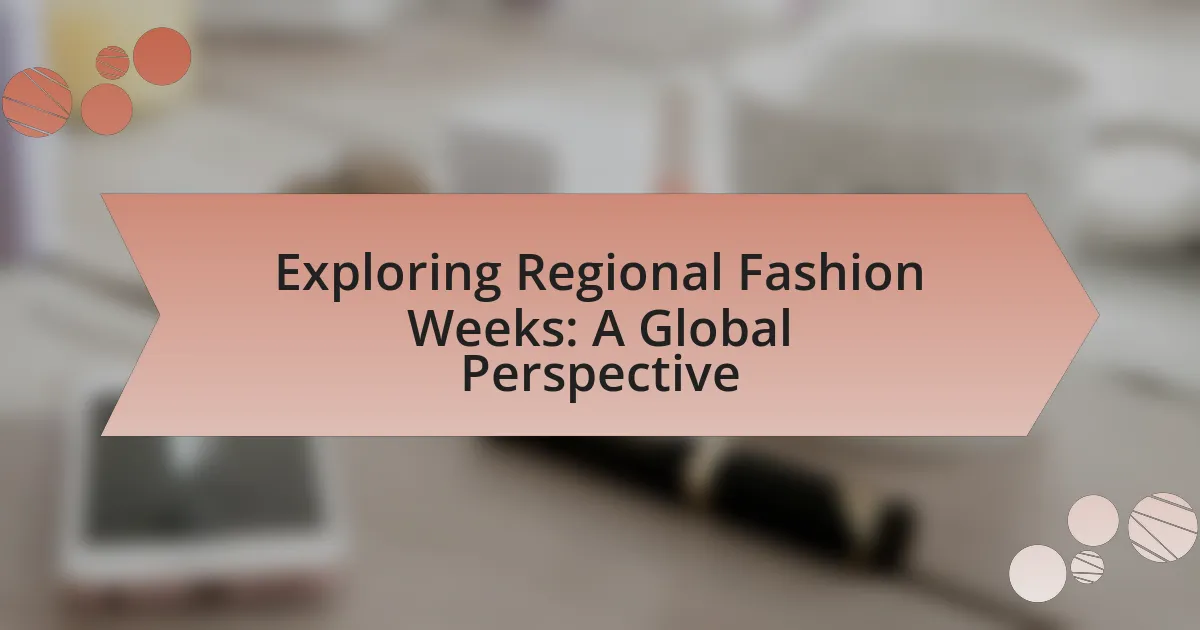Regional Fashion Weeks are significant fashion events held in various cities worldwide, showcasing local designers and trends that differ from those in major fashion capitals. These events emphasize regional talent, cultural influences, and sustainability, providing a platform for emerging designers while stimulating local economies. The article explores the differences between Regional and Global Fashion Weeks, highlights key characteristics and trends, and discusses the economic impact and challenges faced by these events. Additionally, it examines how local designers influence global fashion trends and offers insights into maximizing the experience for attendees and emerging professionals.

What are Regional Fashion Weeks?
Regional Fashion Weeks are fashion events held in various cities around the world, showcasing local designers and trends distinct from the major fashion capitals like Paris, Milan, New York, and London. These events provide a platform for emerging talent and regional styles, often reflecting the cultural and social influences of their locations. For instance, cities such as Tokyo, São Paulo, and Sydney host their own fashion weeks, contributing to the global fashion landscape by highlighting diverse aesthetics and innovative designs that may not be seen in the traditional fashion hubs.
How do Regional Fashion Weeks differ from Global Fashion Weeks?
Regional Fashion Weeks focus on local designers and trends, showcasing regional talent and cultural influences, while Global Fashion Weeks emphasize international brands and global trends, often featuring high-profile designers and extensive media coverage. Regional events typically cater to specific markets, allowing for a more intimate and community-oriented atmosphere, whereas global events attract a worldwide audience and serve as major platforms for industry leaders. For example, New York Fashion Week is recognized for its influence on global fashion, while smaller regional weeks, like those in Lagos or Melbourne, highlight local craftsmanship and cultural narratives.
What are the key characteristics of Regional Fashion Weeks?
Regional Fashion Weeks are characterized by their focus on local designers, cultural influences, and accessibility to a broader audience. These events often showcase emerging talent from specific regions, highlighting unique styles and trends that reflect local heritage and craftsmanship. Additionally, Regional Fashion Weeks tend to be more inclusive, allowing for diverse representation and participation from various demographics, which contrasts with the more exclusive nature of major fashion capitals. The events also emphasize sustainability and community engagement, often collaborating with local artisans and businesses to promote regional economies.
Why are Regional Fashion Weeks important in the fashion industry?
Regional Fashion Weeks are important in the fashion industry because they provide a platform for local designers to showcase their work, fostering creativity and innovation within specific markets. These events help to diversify the fashion landscape by highlighting regional aesthetics and cultural influences, which can lead to the discovery of new talent and trends. For instance, cities like Tokyo, Lagos, and São Paulo have their own fashion weeks that reflect their unique cultural identities, contributing to a more inclusive global fashion narrative. Additionally, regional fashion weeks stimulate local economies by attracting tourism and investment, as seen in cities that host these events, which often experience increased business activity during fashion week periods.
What regions host notable Fashion Weeks?
Notable Fashion Weeks are hosted in major global cities, specifically in regions such as Europe, North America, and Asia. In Europe, Paris, Milan, and London are renowned for their influential fashion events, with Paris Fashion Week being one of the most prestigious globally. North America features New York Fashion Week, which showcases a diverse range of designers and trends. In Asia, Tokyo and Shanghai have emerged as significant players, hosting Fashion Weeks that highlight both local and international talent. These regions are recognized for their impact on global fashion trends and industry standards.
Which cities are recognized for their unique fashion events?
Cities recognized for their unique fashion events include Paris, Milan, New York, and London. These cities host major fashion weeks that attract global attention, showcasing the latest trends and designs from top designers. Paris Fashion Week, for instance, is renowned for its historical significance and is considered the pinnacle of fashion events, while Milan Fashion Week is celebrated for its luxury brands and innovative designs. New York Fashion Week is known for its diverse range of designers and emerging talent, and London Fashion Week emphasizes creativity and avant-garde styles. Each of these cities plays a crucial role in shaping the global fashion landscape.
How do cultural influences shape fashion in different regions?
Cultural influences shape fashion in different regions by dictating aesthetic preferences, material choices, and design motifs that reflect local traditions and values. For instance, in Japan, the use of traditional textiles like kimono fabric in contemporary designs showcases a blend of heritage and modernity, while in Africa, vibrant colors and patterns often symbolize cultural identity and community ties. Historical events, such as colonialism or globalization, also impact regional fashion, leading to the incorporation of diverse elements into local styles. This interplay of culture and fashion is evident in fashion weeks around the world, where designers draw inspiration from their cultural backgrounds, as seen in the use of indigenous motifs in collections presented at events like New York Fashion Week or Paris Fashion Week.
What trends emerge from Regional Fashion Weeks?
Regional Fashion Weeks reveal trends that reflect local culture, sustainability, and inclusivity. Designers often showcase traditional craftsmanship and regional materials, emphasizing a connection to local heritage. For instance, events in cities like Lagos and Mumbai highlight vibrant colors and patterns that resonate with their cultural narratives. Additionally, there is a growing emphasis on sustainable practices, with many designers opting for eco-friendly materials and ethical production methods. This trend aligns with global movements towards sustainability in fashion, as seen in the increasing number of brands participating in initiatives like the Fashion Pact. Furthermore, inclusivity is becoming a focal point, with more diverse models and body types represented on the runway, reflecting a broader societal shift towards acceptance and representation in fashion.
How do local designers influence global fashion trends?
Local designers influence global fashion trends by introducing unique cultural elements and innovative designs that resonate with broader audiences. Their participation in regional fashion weeks showcases local craftsmanship, traditional textiles, and distinct aesthetics, which often inspire international designers and brands. For instance, the rise of African prints in global fashion can be traced back to local designers like Duro Olowu, who incorporate vibrant patterns and cultural narratives into their collections, leading to increased visibility and demand for such styles worldwide. This cross-pollination of ideas not only diversifies the fashion landscape but also encourages global brands to adopt and adapt local influences, thereby shaping trends on a larger scale.
What are the common themes observed in various Regional Fashion Weeks?
Common themes observed in various Regional Fashion Weeks include sustainability, cultural representation, and innovation in design. Sustainability has become a focal point, with many designers showcasing eco-friendly materials and practices, reflecting a global shift towards environmental consciousness in fashion. Cultural representation is evident as designers draw inspiration from local traditions and heritage, promoting diversity and inclusivity within the industry. Additionally, innovation in design is highlighted through the use of technology and new techniques, pushing the boundaries of traditional fashion. These themes collectively illustrate the evolving landscape of fashion on a regional level, aligning with global trends and consumer expectations.

How do Regional Fashion Weeks impact local economies?
Regional Fashion Weeks significantly boost local economies by attracting tourism, increasing retail sales, and creating job opportunities. These events draw fashion enthusiasts, industry professionals, and media, leading to heightened hotel bookings, restaurant patronage, and local shopping. For instance, a study by the Council of Fashion Designers of America indicated that New York Fashion Week generates approximately $600 million in economic impact annually, showcasing how similar regional events can stimulate local financial growth. Additionally, local designers and businesses benefit from increased visibility and networking opportunities, further contributing to economic vitality.
What economic benefits do Regional Fashion Weeks provide?
Regional Fashion Weeks provide significant economic benefits by boosting local economies through increased tourism, job creation, and support for local businesses. These events attract visitors who spend on accommodations, dining, and entertainment, contributing to the overall economic activity of the host city. For instance, a study by the Fashion Institute of Technology found that New York Fashion Week generates approximately $900 million in economic impact annually, a model that regional events can replicate on a smaller scale. Additionally, Regional Fashion Weeks create employment opportunities in various sectors, including fashion design, event management, and hospitality, further enhancing the economic landscape.
How do these events boost tourism in host cities?
Regional fashion weeks boost tourism in host cities by attracting international visitors, increasing hotel occupancy, and stimulating local economies. These events draw fashion enthusiasts, industry professionals, and media, leading to a surge in demand for accommodations, dining, and entertainment. For instance, New York Fashion Week generates approximately $600 million in economic impact annually, showcasing how such events can significantly enhance tourism revenue. Additionally, the visibility and promotion of local culture and attractions during these fashion weeks further entice tourists to explore the host city, contributing to sustained tourism growth.
What role do local businesses play during Fashion Weeks?
Local businesses play a crucial role during Fashion Weeks by providing essential services and products that support the event’s ecosystem. These businesses, including boutiques, restaurants, and hotels, contribute to the local economy by attracting visitors and generating revenue. For instance, during New York Fashion Week, local hotels report increased bookings, and restaurants experience a surge in customers, highlighting the economic impact of the event. Additionally, local designers and artisans often showcase their work, enhancing the diversity and creativity of the fashion scene. This symbiotic relationship between Fashion Weeks and local businesses fosters community engagement and promotes regional talent on a global stage.
How do Regional Fashion Weeks support emerging designers?
Regional Fashion Weeks support emerging designers by providing them with a platform to showcase their collections to industry professionals and potential buyers. These events often feature runway shows, networking opportunities, and workshops that facilitate connections between designers and key stakeholders in the fashion industry. For instance, according to a report by the Council of Fashion Designers of America, regional fashion weeks have been instrumental in launching the careers of numerous designers by increasing their visibility and access to resources. This support is crucial for emerging talent, as it helps them gain recognition and establish their brand in a competitive market.
What opportunities do these events create for new talent?
Regional fashion weeks create significant opportunities for new talent by providing a platform for emerging designers to showcase their work to industry professionals, potential buyers, and media. These events often feature mentorship programs, networking opportunities, and exposure to fashion influencers, which can lead to collaborations and career advancements. For instance, many regional fashion weeks have initiatives that connect new designers with established brands, facilitating valuable partnerships that can enhance visibility and market reach. Additionally, participation in these events can result in media coverage, which is crucial for building a designer’s brand and attracting investment.
How can emerging designers leverage Regional Fashion Weeks for exposure?
Emerging designers can leverage Regional Fashion Weeks for exposure by showcasing their collections to a targeted audience of industry professionals, buyers, and media. These events provide a platform for designers to gain visibility, network with key stakeholders, and potentially secure retail partnerships. For instance, participation in events like New York Fashion Week: The Shows or London Fashion Week can lead to features in fashion publications, as these platforms often attract influential journalists and bloggers. Additionally, regional fashion weeks frequently emphasize local talent, allowing designers to connect with their community and build a loyal customer base. According to a report by the Council of Fashion Designers of America, designers who participate in fashion weeks often see a significant increase in social media following and brand recognition, underscoring the effectiveness of these events for emerging talent.

What challenges do Regional Fashion Weeks face?
Regional Fashion Weeks face several challenges, including limited funding, lower visibility compared to major fashion capitals, and difficulties in attracting top-tier designers and buyers. These events often struggle to secure sponsorships, which impacts their ability to produce high-quality shows and marketing efforts. Additionally, the lack of media coverage and industry recognition can hinder their growth and influence, making it challenging to establish a strong brand identity. According to a report by the Council of Fashion Designers of America, regional fashion events often receive less than 10% of the media attention that New York Fashion Week garners, highlighting the disparity in visibility and support.
How do economic factors affect the sustainability of Regional Fashion Weeks?
Economic factors significantly impact the sustainability of Regional Fashion Weeks by influencing funding, sponsorship, and consumer spending. Limited financial resources can restrict the ability of organizers to host events, attract designers, and promote the fashion week effectively. For instance, a study by the Fashion Institute of Technology found that economic downturns lead to reduced sponsorship from brands, which directly affects the scale and visibility of these events. Additionally, fluctuations in consumer spending can determine attendance rates and overall sales during the fashion week, as seen in various regions where economic instability resulted in lower participation from both attendees and retailers. Thus, the economic landscape plays a crucial role in shaping the viability and longevity of Regional Fashion Weeks.
What are the common financial challenges faced by organizers?
Organizers of regional fashion weeks commonly face financial challenges such as securing adequate funding, managing cash flow, and controlling costs. Securing funding is often difficult due to reliance on sponsorships and ticket sales, which can fluctuate significantly. Managing cash flow is critical, as expenses such as venue rental, marketing, and production can accumulate quickly, often outpacing income. Additionally, controlling costs is essential, as organizers must balance quality production with budget constraints, leading to potential compromises in event execution. These challenges are supported by industry reports indicating that many fashion events operate on tight budgets, with a significant percentage reporting financial losses in their inaugural years.
How do competition and market saturation impact these events?
Competition and market saturation significantly influence regional fashion weeks by affecting the diversity of participants and the overall quality of the events. High competition among designers and brands can lead to innovative showcases, as participants strive to differentiate themselves. Conversely, market saturation may result in a diluted experience, where numerous similar events compete for attention, making it challenging for individual fashion weeks to stand out. For instance, in cities with multiple fashion weeks, such as New York and London, the abundance of events can lead to overlapping schedules and audience fatigue, ultimately impacting attendance and media coverage. This dynamic illustrates how competition can drive creativity, while saturation can hinder the unique appeal of regional fashion weeks.
What logistical issues arise during Regional Fashion Weeks?
Logistical issues during Regional Fashion Weeks include venue selection, transportation of models and materials, scheduling conflicts, and coordination among various stakeholders. Venue selection can be challenging due to limited availability and the need for appropriate space to accommodate designers, models, and audiences. Transportation issues arise from the need to move large quantities of clothing, accessories, and equipment, often across long distances, which can lead to delays. Scheduling conflicts may occur when multiple events overlap, making it difficult for attendees to participate in all desired shows. Coordination among designers, sponsors, and production teams is crucial, as miscommunication can lead to errors in show execution. These logistical challenges can significantly impact the overall success and smooth operation of Regional Fashion Weeks.
How do organizers manage venue selection and scheduling?
Organizers manage venue selection and scheduling by conducting thorough research on potential locations, assessing factors such as capacity, accessibility, and amenities. They often utilize data analytics to evaluate past event performances at various venues, ensuring that the selected site aligns with the event’s goals and audience expectations. Additionally, organizers negotiate contracts and timelines with venue managers to secure dates that accommodate their event schedule, often considering peak seasons and local events to avoid conflicts. This strategic approach is supported by industry standards, which emphasize the importance of logistical planning in successful event execution.
What are the challenges of coordinating with designers and models?
Coordinating with designers and models presents several challenges, primarily due to differing creative visions and communication barriers. Designers often have specific artistic concepts that may not align with the models’ interpretations or capabilities, leading to potential conflicts during the creative process. Additionally, logistical issues such as scheduling conflicts, availability of models, and last-minute changes in design can complicate coordination efforts. For instance, a study by the Fashion Institute of Technology highlights that 70% of fashion professionals cite communication as a critical barrier in successful collaborations. This statistic underscores the importance of clear dialogue and mutual understanding in overcoming these challenges.
What strategies can enhance the success of Regional Fashion Weeks?
To enhance the success of Regional Fashion Weeks, organizers should focus on building strong local partnerships, leveraging digital marketing, and curating diverse talent. Strong local partnerships with businesses, media, and influencers can increase visibility and support, as evidenced by the success of events like New York Fashion Week, which thrives on local collaborations. Digital marketing strategies, including social media campaigns and live streaming, can broaden audience reach and engagement, as shown by the rise of virtual attendance during the pandemic. Additionally, curating diverse talent not only reflects the community’s culture but also attracts a wider audience, similar to how Paris Fashion Week has successfully showcased emerging designers from various backgrounds.
How can collaboration with local businesses improve outcomes?
Collaboration with local businesses can improve outcomes by enhancing community engagement and driving economic growth. When regional fashion weeks partner with local businesses, they create a platform for showcasing local talent and products, which fosters a sense of community and encourages consumer support for local enterprises. This collaboration can lead to increased foot traffic and sales for local shops, as evidenced by a study from the American Independent Business Alliance, which found that local businesses recirculate a greater share of every dollar as they create locally owned supply chains and invest in their communities. Additionally, such partnerships can result in innovative marketing strategies that leverage local culture and trends, ultimately leading to a more vibrant and sustainable fashion ecosystem.
What marketing techniques can attract more attendees and media coverage?
Utilizing social media campaigns, influencer partnerships, and targeted email marketing can significantly attract more attendees and media coverage for regional fashion weeks. Social media platforms like Instagram and TikTok allow for visually engaging content that can reach a broad audience, with statistics showing that 54% of consumers use social media to research products. Collaborating with influencers who resonate with the target demographic can amplify reach and credibility, as 49% of consumers depend on influencer recommendations. Additionally, targeted email marketing can effectively engage previous attendees and interested parties, with a reported average return on investment of $42 for every dollar spent. These techniques, when executed strategically, can enhance visibility and participation in regional fashion events.
What are best practices for attending Regional Fashion Weeks?
To effectively attend Regional Fashion Weeks, individuals should prioritize thorough research on the event schedule, designers, and key trends. This preparation allows attendees to maximize their experience by identifying which shows and presentations align with their interests and professional goals. Additionally, networking is crucial; engaging with industry professionals and fellow attendees can lead to valuable connections and insights. Dressing appropriately for the event is also essential, as fashion weeks are platforms for showcasing personal style and professionalism. Furthermore, arriving early ensures a good seat and the opportunity to absorb the atmosphere before the shows begin. These practices are supported by the fact that successful attendees often report enhanced experiences and networking opportunities when they are well-prepared and proactive.
How can attendees maximize their experience at these events?
Attendees can maximize their experience at regional fashion weeks by actively engaging in networking opportunities and participating in workshops. Engaging with industry professionals and fellow attendees fosters valuable connections that can lead to future collaborations. Additionally, participating in workshops enhances skills and knowledge about current trends and techniques in fashion, which is crucial in a rapidly evolving industry. Research indicates that networking can significantly impact career advancement, with 70% of jobs being filled through personal connections, highlighting the importance of building relationships at these events.
What should aspiring fashion professionals know before attending?
Aspiring fashion professionals should understand the significance of networking and research before attending fashion weeks. Networking is crucial as it allows individuals to connect with industry leaders, designers, and peers, which can lead to job opportunities and collaborations. Researching the specific fashion week, including its history, featured designers, and target audience, is essential for tailoring one’s approach and maximizing the experience. For instance, knowing that New York Fashion Week is known for its commercial focus while Paris Fashion Week emphasizes haute couture can guide professionals in aligning their expectations and strategies.
